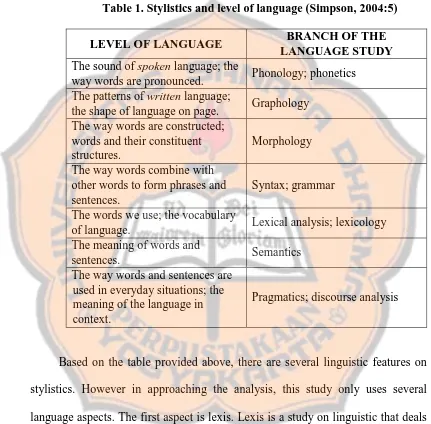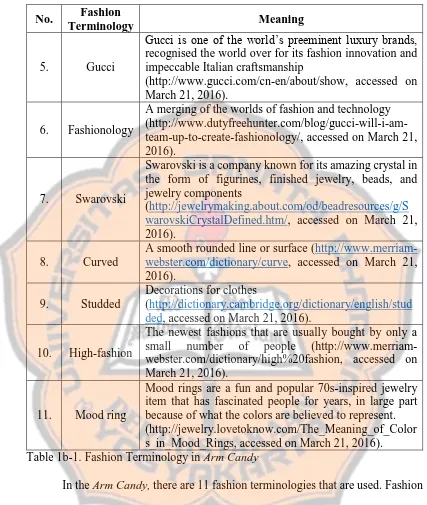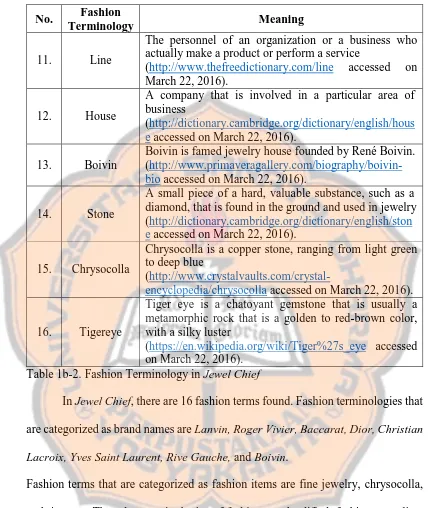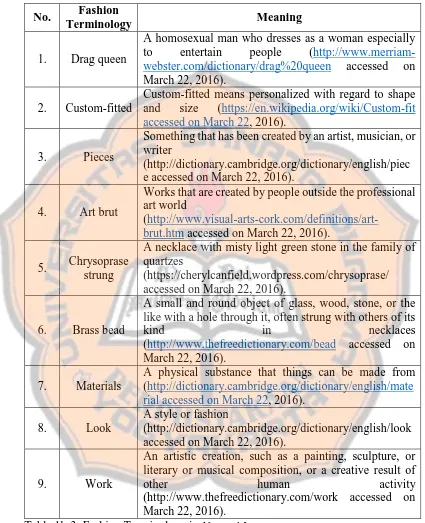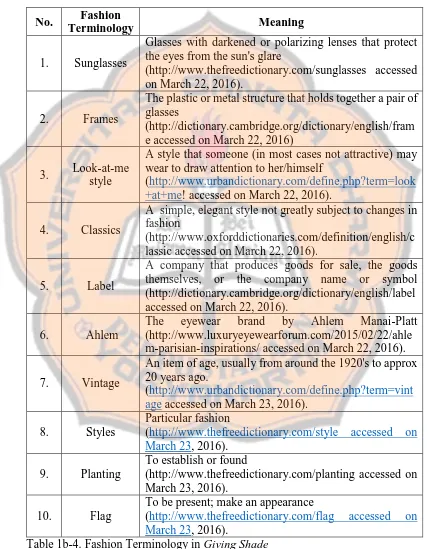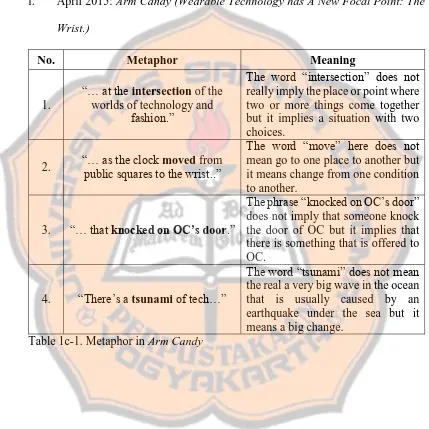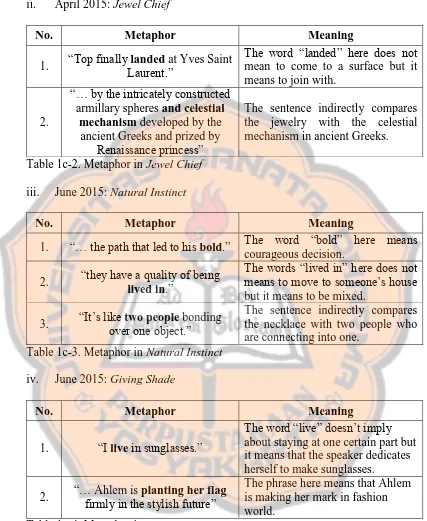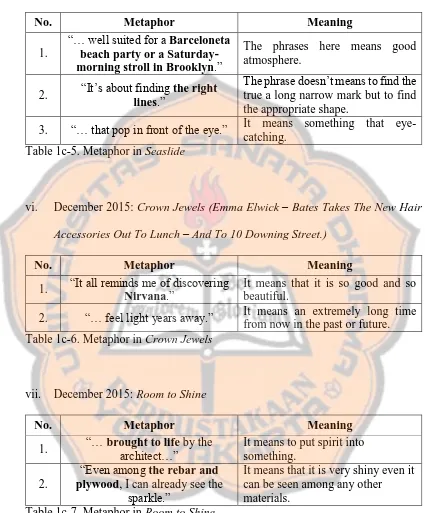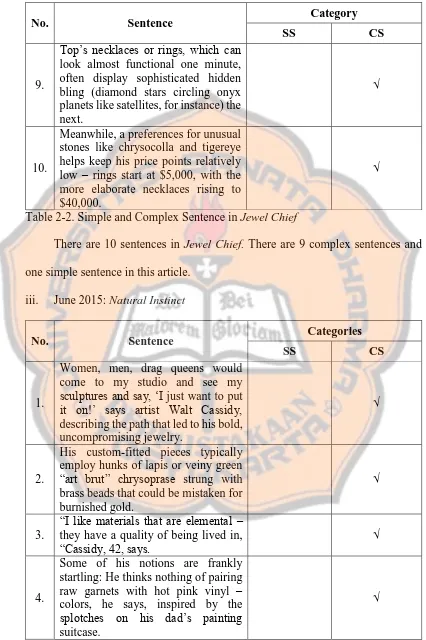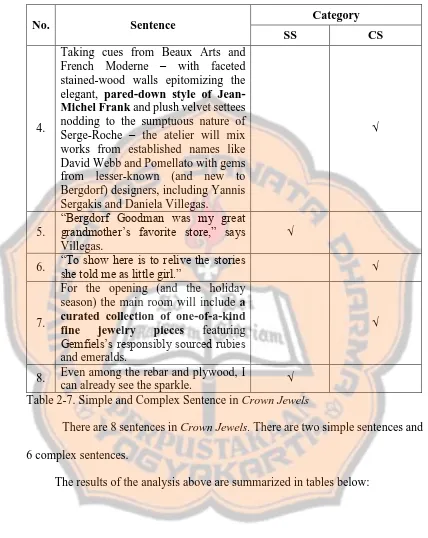xii ABSTRACT
FAMILA, ANGELICA CHRESTELLA. A Stylistic Analysis on the View Column in Vogue Magazine April 2015, June 2015, and December 2015 Edition. Yogyakarta: Department of English Letters, Faculty of Letters, Sanata Dharma University, 2016.
Mass media have important roles as a tool that is used to reach mass audience. Mass media can transmit information through written or digital tools. One of the examples of mass media is a magazine. A magazine is the electronical or printed periodical publications containing articles, advertisements, fictions, photographs, and other columns. It is used to represent the idea and information of specific and special interests. It is also used to tell the readers about the latest products that are being offered. Vogue is one of the most well-known magazines in the fashion world. It is associated with the luxury-end of fashion and lifestyle. One of the column in Vogue that contain the review of fashion products and styles is the View Column. The articles in View magazine successfully catch people’s attention since the first time it is published. Therefore the articles of View column in Vogue are deserved to be analyzed.
There are two objectives in this study. The first is to discover and identify lexical and syntactic features that are used in the View column from Vogue magazine. The second is to discover how lexical and syntactic features on the View column in Vogue magazine are exploited for persuasive purposes. The purpose of this study is to prove that Vogue magazine used several language features that are exploited for persuasive purposes.
There were several steps taken to complete this study. In collecting data, the purposive sampling techniques were used. The data were taken from View column in Vogue magazine April 2015, June 2015, and December 2015 Edition.After the data were collected, the data were analyzed by dealing with the language features which are lexical and syntactic features found in the Vogue magazine. The analysis was continued by matching the language features applied in the magazine with theory of persuasive language by Timothy A. Borchers (2005).
xiii ABSTRAK
FAMILA, ANGELICA CHRESTELLA. A Stylistic Analysis on the View Column in Vogue Magazine April 2015, June 2015, and December 2015 Edition. Yogyakarta: Program Studi Sastra Inggris, Fakultas Sastra, Universitas Sanata Dharma, 2016.
Media massa memiliki peran penting sebagai alat yang digunakan untuk mendekati masyarakat dalam jumlah yang besar. Media massa dapat menyampaikan informasi baik secara tertulis ataupun digital. Salah satu contoh dari media massa adalah majalah. Majalah merupakan sebuah publikasi berkala yang dicetak ataupun ditampilkan secara elektronik yang mengandung artikel, iklan, fiksi, foto, dan kolom lainnya. Majalah digunakan untuk menginformasikan pembaca tentang produk-produk terbaru yang ditawarkan. Vogue adalah salah satu majalah paling terkenal di dunia fashion. Majalah ini terkait dengan fashion dan gaya hidup kelas atas. Salah satu kolom dalam majalah Vogue yang membahas tentang produk dan gaya fashion adalah kolom View. Artikel yang ada di kolom View ini berhasil menangkap perhatian pembaca sejak pertama kali diterbitkan. Oleh karena itu artikel di kolomini layak untuk dianalisis.
Ada dua permasalahan yang dibahas dalam penelitian ini. Yang pertama adalah menemukan dan mengidentifikasi fitur lesikal dan sintaktis yang digunakan didalam kolom View dari majalah Vogue. Yang kedua adalah menemukan bagaimana fitur tersebut di gunakan untuk tujuan persuasif.
Ada beberapa langkah yang digunakan untuk menyelesaikan penelitian ini. Dalam proses pengumpulan data, penelitian ini menggunakan teknik pengambilan data secara acak. Data yang digunakan diambil dari kolom View di majalah Vogue edisi April 2015, Juni 2015, dan Desember 2015. Setelah terkumpul, data tersebut akan dianalisis berdasarkan fitur leksikal dan sintaktis. Analisis dilanjutkan dengan mencocokkan fitur-fitur tersebut dengan teori persuasive dari Timothy A. Borchers. (2005)
A STYLISTIC ANALYSIS ON THE VIEW COLUMN IN
VOGUE MAGAZINE APRIL 2015, JUNE 2015, AND
DECEMBER 2015 EDITION
AN UNDERGRADUATE THESIS
Presented as Partial Fulfillment of the Requirements
For the Degree of Sarjana Sastra
In English Letters
By
ANGELICA CHRESTELLA FAMILA
Student Number: 124214117
ENGLISH LETTERS STUDY PROGRAM
DEPARTMENT OF ENGLISH LETTERS
FACULTY OF LETTERS
SANATA DHARMA UNIVERSITY
YOGYAKARTA
ii
A STYLISTIC ANALYSIS ON THE VIEW COLUMN IN
VOGUE MAGAZINE APRIL 2015, JUNE 2015, AND
DECEMBER 2015 EDITION
AN UNDERGRADUATE THESIS
Presented as Partial Fulfillment of the Requirements
For the Degree of Sarjana Sastra
In English Letters
By
ANGELICA CHRESTELLA FAMILA
Student Number: 124214117
ENGLISH LETTERS STUDY PROGRAM
DEPARTMENT OF ENGLISH LETTERS
FACULTY OF LETTERS
SANATA DHARMA UNIVERSITY
YOGYAKARTA
v
LEMBAR PERNYATAAN PERSETUJUAN PUBLIKASI KARYA ILMIAH UNTUK KEPENTINGAN AKADEMIS
Yang bertanda tangan di bawah ini, saya mahasiswa Universitas Sanata Dharma Nama : Angelica Chrestella Famila
Nomor Mahasiswa : 124214117
Demi pengembangan ilmu pengetahuan, saya memberikan kepada Perpustakaan Universitas Sanata Dharma karya ilmiah saya yang berjudul
A STYLISTIC ANALYSIS ON THE VIEW COLUMN IN
VOGUE MAGAZINE APRIL 2015, JUNE 2015, AND
DECEMBER 2015 EDITION
beserta perangkat yang diperlukan (bila ada). Dengan demikian saya memberikan kepada Perpustakaan Universitas Sanata Dharma hak untuk menyimpan, mengalihkan dalam bentuk media lain, mengelolanya dalam bentuk pangkalan data, mendistribusikan secara terbatas, dan mempublikasikannya di internet atau media lain untuk kepentingan akademis tanpa perlu meminta izin kepada saya maupun memberikan royalty kepada saya selama tetap mencantumkan nama saya sebagai penulis.
Demikian pernyataan ini saya buat dengan sebenarnya.
Dibuat di Yogyakarta Pada tanggal 5 Juni 2016
Yang menyatakan,
vi
STATEMENT OF ORIGINALITY
I honestly declared that this undergraduate thesis contains no material which has been submitted previously for the award of any other degree at any university, and that, to the best of my knowledge, this undergraduate thesis contains no material previously written by any other people except where due reference is made in the text of the undergraduate thesis.
Yogyakarta, June 5, 2016
vii
YOU CAN’T STOP THE WAVE BUT YOU CAN LEARN TO SURF
viii
For
My beloved family
My comrade in arms
And
ix
ACKNOWLEDGEMENTS
First, and most of all I would like to express my deepest gratitude to Jesus Christ for guiding me in my walk every day and for carrying me when I lose my way. I am also thankful for the love of my family. I would like to thank my beloved mommy Venny Lilius and my beloved daddy Budiyono Famila for supporting me psychologically and financially also to my look-a-like brother Richard Jefferson for letting me to be the first who grab the bachelor degree.
Foremost, I would like to thank my advisor Dr. Fr. B. Alip, M.Pd, M.A. for every second he spent guiding and giving advice for finishing my thesis. I would also thank my co-advisor, Anna Fitriati, S.Pd., M. Hum. for her detailed correction and suggestion. I also would thank Mbak Ninik for her kindness in helping me with the administrative procedures.
I also want to thank Anita Sulistiyawati for being my partner in crime for all these years. I would also thank my comrades, E-United. I also want to extend my thankfulness for Oktadea Herda Pratiwi, Dana, Upik, Tyas, Nuri, Arik, Wiwik, Rendy, Ferdhia, Fuad, Yuda, Bella, Agung, Maya, Dhinar, Sri, Sekar, Iduy, Mr. Bob, and all of my friends who cannot be mentioned one by one. Last, I want to thank every person who has ever told me I cannot because they are just another reason why I will.
x
TABLE OF CONTENTS
TITLE PAGE ……… ii
APPROVAL PAGE ……….. iii
ACCEPTANCE PAGE ………. iv
LEMBAR PENGESAHAN PUBLIKASI KARYA ILMIAH ……… v
STATEMENT OF ORIGINALITY ……… vi
MOTTO PAGE ………. vii
DEDICATION PAGE ……….. viii
ACKNOWLEDGEMENTS ………. ix
TABLE OF CONTENTS ………. x
ABSTRACT ……… xii
ABSTRAK ……….. xiii
CHAPTER I: INTRODUCTION ………....… 1
A. Background of the Study ………. 1
B. Problem Formulation ………... 4
C. Objectives of the Study ……… 4
D. Definition of Terms ………. 5
CHAPTER II: REVIEW OF LITERATURE ………... 7
A. Review of Related Study ………. 8
B. Review of Related Theories ………... 11
1. Theory of Stylistics ……… 11
a. Lexical Features ………... 14
b. Syntactic Features ……… 16
2. Theory of Persuasion ………. 17
a. Language Intensity ………... 18
b. Powerful Language ……….. 19
c. Language and Imagery ……… 19
xi
e. Metaphor ……….. 20
C. Theoretical Framework ………...………. 21
CHAPTER III: METHODOLOGY ……… 23
A. Object of the Study ……… 23
B. Approach of the Study ……… 24
C. Method of the Study ……….. 27
1. Data Collection ………. 27
2. Data Analysis ………. 28
CHAPTER IV: ANALYSIS ……….. 30
A. Analysis on Lexical and Syntactical Features ………... 30
1. Lexical Features ………... 30
2. Syntactic Features ……… 50
B. Analysis on Persuasive Strategies ………. 66
1. Language Intensity ……….. 66
2. Powerful Language ……….. 68
3. Language and Imagery ……… 69
4. Rhetorical Figures ……… 69
5. Metaphor ………... 70
CHAPTER V: CONCLUSION ………. 71
BIBLIOGRAPHY ……… 74
xii ABSTRACT
FAMILA, ANGELICA CHRESTELLA. A Stylistic Analysis on the View Column in Vogue Magazine April 2015, June 2015, and December 2015 Edition. Yogyakarta: Department of English Letters, Faculty of Letters, Sanata Dharma University, 2016.
Mass media have important roles as a tool that is used to reach mass audience. Mass media can transmit information through written or digital tools. One of the examples of mass media is a magazine. A magazine is the electronical or printed periodical publications containing articles, advertisements, fictions, photographs, and other columns. It is used to represent the idea and information of specific and special interests. It is also used to tell the readers about the latest products that are being offered. Vogue is one of the most well-known magazines in the fashion world. It is associated with the luxury-end of fashion and lifestyle. One of the column in Vogue that contain the review of fashion products and styles is the View Column. The articles in View magazine successfully catch people’s attention since the first time it is published. Therefore the articles of View column in Vogue are deserved to be analyzed.
There are two objectives in this study. The first is to discover and identify lexical and syntactic features that are used in the View column from Vogue magazine. The second is to discover how lexical and syntactic features on the View column in Vogue magazine are exploited for persuasive purposes. The purpose of this study is to prove that Vogue magazine used several language features that are exploited for persuasive purposes.
There were several steps taken to complete this study. In collecting data, the purposive sampling techniques were used. The data were taken from View column in Vogue magazine April 2015, June 2015, and December 2015 Edition.After the data were collected, the data were analyzed by dealing with the language features which are lexical and syntactic features found in the Vogue magazine. The analysis was continued by matching the language features applied in the magazine with theory of persuasive language by Timothy A. Borchers (2005).
xiii ABSTRAK
FAMILA, ANGELICA CHRESTELLA. A Stylistic Analysis on the View Column in Vogue Magazine April 105, June 2015, and December 2015 Edition. Yogyakarta: Program Studi Sastra Inggris, Fakultas Sastra, Universitas Sanata Dharma, 2016.
Media massa memiliki peran penting sebagai sebuah alat yang digunakan untuk mendekati masyarakat dalam jumlah yang besar. Media massa dapat menyampaikan informasi baik secara tertulis ataupun digital. Salah satu contoh dari media massa adalah majalah. Majalah adalah sebuah publikasi berkala yang dicetak ataupun ditampilkan secara elektronik yang mengandung artikel, iklan, fiksi, foto, dan kolom lainnya. Majalah digunakan untuk menginformasikan pembaca tentang produk-produk terbaru yang ditawarkan. Vogue adalah salah satu majalah paling terkenal di dunia fashion. Majalah ini terkait dengan fashion mewah dan juga gaya hidup. Artikel yang ada di majalah ini berhasil menangkap perhatian pembaca sejak pertama kali diterbitkan. Oleh karena itu artikel di majalah ini layak untuk dianalisis.
Ada dua permasalahan yang dibahas dalam penelitian ini. Yang pertama adalah menemukan dan mengidentifikasi fitur lesikal dan sintaktis yang digunakan didalam kolom View dari majalah Vogue. Yang kedua adalah menemukan bagaimana fitur tersebut di gunakan untuk tujuan persuasif.
Ada beberapa langkah yang digunakan untuk menyelesaikan penelitian ini. Teknik pengambilan sampel secara acak dan dengan tujuan tertentu digunakan dalam mengumpulkan data. Data diambil dari kolom View majalah Vogue edisi April 2015, Juni 2015, dan Desember 2015. Setelah data dikumpulkan, data tersebut dianalisis dengan beberapa fitur bahasa yaitu lesikal dan sintaktis yang ditemukan di dalam majalah. Analisis dilanjutkan dengan mencocokkan fitur bahasa yang diterapkan dengan teori bahasa persuasif oleh Timothy A. Borchers.
1 CHAPTER I INTRODUCTION
A. Background of the Study
Nowadays, people get information easily through mass media. Mass media is a tool that is used to reach mass audience. It has a very big role as a disseminator of information. Besides, it is also a tool for conveying news, researches, opinions, or general ideas of things. Therefore, it can form a public opinion for some specific classes in society.
2
On the magazine, the text producer needs to pack a lot of information by putting words together into a short and simple column in purpose to tell the readers the information in brief. The language of the magazines will reflect their specialist nature (McLoughlin, 2000:2). That is why the use of language on the magazine is indispensable. The text producer may use any linguistic features such as graphological features and lexical features to attract the readers. Besides, it also can make the language clear and direct, polished, noble, and also vivid (Ross, 1994:64). This study focuses on language features in View column of Vogue magazine. Vogue is part of a huge network of magazines and publications. It is associated with
the luxury-end of fashion and lifestyle. Its readers are generally considered to be from the middle- to upper class. Vogue is published since 1892 in the United States as a weekly high-society journal. In 1909, Vogue transformed it into a women’s fashion magazine focused on beauty, composure, and etiquette. In 2009 The New York Times christened Vogue “high fashion’s bible” (http://www.britannica.com/topic/Vogue-American-magazine, accessed on January 14, 2016). The total of Vogue’s circulation in 2013 is 1,259,826
In 2015, Vogue magazine took home the grand prize of the award for Magazine of the Year that recognizes general excellence in print and digital media as well as other facets including branded content and events by the National Magazine Awards Foundation (http://blog.magazine-awards.com/2015/ 02 /04/ vogue-new-york-new-yorker-big-winners-at-us-national-magazine-awards/,
accessed on January 14, 2016).
Based on the facts mentioned earlier, it can be concluded that Vogue magazine successfully catches people’s attention by having many achievements since the first time it published. Vogue influences the readers and becomes a trendsetter in fashion world. The products and trends that are described by Vogue magazine will be easily accepted by the readers. It is believed that these achievements are not only because of the models, the fashion items, or the fashion figures, but also the power of language used in the articles. Besides the photographs and pictures that are used, the language used in the magazine also has significant roles to the magazine itself. The text producers of Vogue magazine use certain linguistic features in their articles to make the character of Vogue magazine.
The result of the analysis of language features from the magazine will be used to answer the second aim of this study which is to discover how language features in the View column from Vogue magazine are exploited for persuasive purposes. To support this aim, theory of persuasive language is needed. By using the theory of persuasive language, the way how persuasive purposes are delivered thorough language features is revealed.
B. Problem Formulation
Based on the background mentioned earlier, there are two problems used for the next analysis of this study. The problems are formulated as follows:
1. What are lexical and syntactic features used on the View column in Vogue magazine?
2. How are lexical and syntactic features on the View column in Vogue magazine exploited for persuasive purposes?
C. Objectives of the Study
features. By analyzing lexical features, the words including proper noun, fashion terminology, and metaphor used on the articles are revealed. By analyzing syntactic features, this study exposes how the sentences on the articles are grammatically written.
The result of the analysis of language features from the magazine will be used to answer the second aim of this study which is to discover how lexical and syntactic features on the View column in Vogue magazine are exploited for persuasive purposes. This study uses theory of persuasive language by Timothy A. Borchers to support this aim. By using the theory of persuasive language, this study will be able to identify the way how both lexical and syntactic features are used for persuasive purposes.
D. Definition of Terms
There are several terms used in this study that the writer wants to define in order to focus to the study and to avoid misunderstanding and misleading interpretation.
According to Oxford Advanced Learner's Dictionary (2004 edition), a magazine is "a type of large thin book with a paper cover that you can buy every week or month, containing articles, photographs, etc., often on a particular topic" (2000:804). It means that a magazine is a periodical paperback publications containing various contents. According to Linda McLoughlin, the original meaning of the word magazine is storehouse of information (2002:2) Therefore, a magazine is commonly intended to collect some related stuffs and bundle them together in one package. Usually a magazine contains only one special interest, such as fashion, sport, or gadget.
7
CHAPTER II
REVIEW OF LITERATURE
This chapter covers three main parts. The first part of this study is about the review of related studies. To support this study, the writes uses four studies. The studies are taken from undergraduate theses of English Letters Department Sanata Dharma University which are A Style of the Coca-Cola Advertisements and Its Persuasive Effects toward the Readers by Oktadea Herda Pratiwi, Linguistic
Features in Football Magazine: A Stylistic Analysis on the Club Focus Column in
"World Soccer" Magazine by Yoshua Setyo Nugroho Wibowo, A Study of
Language and Sign in TIME Magazine's Front Covers Issued in January to
December 2006: Stylistics-Semiotics Approach by Felix Suparno, and Language
Features of the Slogans on Cheetos Snacks in 1970s-2013 by Sisilia Dyah Ayu
A. Review of Related Studies
In this part, the writer has searched four related studies which more or less have the same theme, analysis, or approach to support this study. Those related studies are taken from undergraduate theses of English Letters Department Sanata Dharma University.
The first study is A Style of the Coca-Cola Advertisements and Its Persuasive Effects toward the Readers by Oktadea Herda Pratiwi. Pratiwi analyzes language
style used by Coca-Cola advertisements in 125 Years Booklet of the Coca-Cola Company by using stylistic approach. She finds that Coca-Cola advertisement uses several aspect of Stylistics such as graphology, lexis, and syntax to form its slogans. After Pratiwi has categorized language style used on Coca-Cola advertisement, she analyzes how the linguistic features of the language style on the Coca-Cola advertisements create persuasive effects toward young reader who learn English as a foreign language. She uses theory of persuasion to complete the analysis.
The similarity between this study and Pratiwi’s study is the approach of the study. Study from Oktadea Herda Pratiwi uses stylistics and persuasive language as the approach. From her study, this study learns how the language features are formed in group of words by using graphological, lexical, and syntactic features. Unlike Pratiwi’s study, this study analyzes language features in the magazine only
The second study is written by Yoshua Setyo Nugroho Wibowo entitled Linguistic Features in Football Magazine: A Stylistic Analysis on the Club Focus
Column in "World Soccer" Magazine. Wibowo analyzes the language styles by
exploring the linguistic features and the element of writing. He also analyzes the possible effects that contributed by the linguistic features toward the readers. He collects the data from the Club Focus column in “World Soccer” magazine. In order to support his data analysis, Wibowo uses stylistic approach. He finds the linguistic features based on their graphological and lexical features. After that he finds out the possible effects of those linguistic features toward the readers. For his conclusion, he stated that the articles on the Club Focus column in "World Soccer" magazines are written in standard punctuation and capitalization. The articles also use some metaphors and football terms. Therefore, the readers can understand the content of the articles seen from football point of view easily.
The study from Yoshua Setyo Nugroho Wibowo also has similarity with this study on the object of the study. Wibowo’s study and this study use magazine as the data. Wibowo analyzes the soccer magazine through graphological and lexical features while this study analyzes fashion magazine through lexical and syntactic features. Nugroho also continues his analysis to know possible effects that contribute by the language features.
The third study with the title A Study of Language and Sign in TIME Magazine's Front Covers Issued in January to December 2006: Stylistics-Semiotics
Approach is written by Felix Suparno. To help his study, Suparno collects the data
discusses about the language styles used in TIME's headlines and the semiotic interpretations of the written texts and the visual objects found in the data. Suparno uses the approach of stylistics and semiotics as groundwork of his study. In the end, he comes to certain findings. The first is that TIME employs certain stylistics devices in its headlines to attract the readers. The second is that TIME's cover delivers powerful semiotics devices which create certain particular meanings and effect for the readers. He also finds that symbol and icon are prominent types of sign found in TIME magazine front covers.
The similarity of between this study with Suparno’s study is only on one of the approach. Suparno’s study also uses stylistics approach to analyze the problems but it focuses on grammatical and sound patterns. Besides, Suparno also uses another theory which is semiotics. The rest of the analysis are different.
The fourth study is Sisilia Dyah Ayu Retno Kusumawardhani’s study
“Language Features of the Slogans on Cheetos Snacks in 1970s-2013”.
sentences and complex sentences. She also concludes that the advertiser applied language intensity, powerful language, language and imagery, and rhetorical figures to attract consumer to but the product.
Although this study uses the same approach which are stylistics and persuasive language, this study has different object of study which is a magazine. From the study of Kusumawardhani, this study can learn about the language styles that also have persuasive effect to the readers.
This study aims to improve the analysis of those studies above by using the analysis of lexical and syntactic features in Vogue magazine, especially on the View column. Thereafter, the result of the analysis of language features from the magazine will be used to discover how language features on the View column in Vogue magazine are exploited for persuasive purposes.
B. Review of Related Theories
In this part, the writer uses several theories which related to the problem formulation to analyze the study. The writer uses theories of stylistics and persuasion. Both theories are described below.
1. Stylistics
to represent the products. Thereupon, it can be said that a magazine used its own distinctive features. In order to analyze the features, stylistics analysis is needed.
Verdonk in his book defined stylistics as the analysis of distinctive expression in language and the description of its purposes and effect (2002:4). It means style is a typical manner of expression that uses various levels of language to express an idea. A style includes how analysis and description should be conducted and established.
In one way or another, styles in language make reference to a distinctive manner of expression, through whatever medium this expression is given physical shape (Verdonk, 2002:3). It can be found in particular literary genres or in the works of individual writers. Stylistics can create various styles in language that brings certain meaning to the reader. It also can create understanding of literature, linguistics, and journalism.
Paul Simpson in his book says that stylistics is a method of textual interpretation in which primacy of place is assigned on language (2004:2). He also states that the reason why language is so important to stylistics is because the various forms, patterns and levels that constitute linguistic structure are an important index of the function of the text (2004:2).
Stylistics also has its own distinctive feature. It can be used as an expression or hidden message of languages. It enriches readers’ ways of thinking about
elaborate language and creativity in any purposes. Thus, in order to identify and organize the stylistics analysis of the text, a table of categories, major levels of language, and their related technical term is attached.
Table 1. Stylistics and level of language (Simpson, 2004:5)
LEVEL OF LANGUAGE BRANCH OF THE
LANGUAGE STUDY The sound of spoken language; the
way words are pronounced. Phonology; phonetics The patterns of written language;
the shape of language on page. Graphology The way words are constructed;
words and their constituent structures.
Morphology The way words combine with
other words to form phrases and sentences.
Syntax; grammar The words we use; the vocabulary
of language. Lexical analysis; lexicology The meaning of words and
sentences. Semantics
The way words and sentences are used in everyday situations; the meaning of the language in context.
Pragmatics; discourse analysis
of a language and the relationship between words. Syntax features that are used for this study are simple sentence and complex sentence. From those aspects above, it can be concluded that this study only focuses on vocabulary and grammatical structures of the texts.
a. Lexical Features
Lexis is the whole of vocabulary items in a language, including all forms having lexical meaning or grammatical function. Lexis is used as a general technical term for vocabulary or diction. It is linked with grammar as a component of language. According to Wales, lexis is the most important means that people have in order to express the idea and experience (2001:234). Therefore, in order to give the reader the idea or argument of articles, lexical features are needed. Wales also states that "words having similar collocation ranges and recurring in similar contexts are said to belong to the same lexical set." (2001:234). Therefore, in the lexical features, the words have the same ranges and contexts.
i. Proper Noun
ii. Fashion Terminology
According to Oxford Advanced Learner’s Dictionary sixth edition, fashion is
“a popular style of clothes, hair, etc at a particular time or place.” (2000:481). It is
also the prevailing type of clothing that is favored by a large segment of the public at any given time. The word ‘term’ means a word or phrase used as the name of something especially one connected with a particular type of language. (2000:1394) Therefore, a fashion term is the words that used with particular fashion style. It provides definitions of fashion vocabulary like clothing construction terms, apparel definitions, clothing detail terminology, fashion design jargon and other terms as they relate to the fashion industry. Fashion terms help people to understand the articles in the taste of fashion.
iii. Metaphor
b. Syntactic Features
Syntax or usually is known as grammatical features is the set of rules, principles, and processes that manage the structure of sentences in a given language, specifically word order. Paul Simpson says that most theories of grammar accept that grammatical units are ordered hierarchically according to their size. This hierarchy is known as a rank scale (2004:10).
Sentence (or clause complex)
Clause
Phrase (or group)
Word
Morpheme
i. Simple Sentence
A simple sentence is a sentence with just a main clause (Wales, 2001:356). It only contains one independent clause. An independent clause is a group of words (with a subject or a verb) that states a complete thought. It only requires one punctuation mark at the end such as a full stop, exclamation, or question mark. ii. Complex Sentence
A complex sentence is a sentence that has a main clause and one or more adverbial clauses. A complex sentence contains more than one clause in a sentence (Wales, 2001:356). It contains a dependent clause and an independent clause. When the dependent clause comes first, it is separated with a comma. When the sentence begins with the independent clause, there is no need to separate the clauses with a comma.
2. Theory of Persuasion
Persuasion is "a change process resulting mostly from shared, symbolic thinking activity". It is concerned with social influence and human motivation (Ross, 1994:7). It can be said that persuasion is a technique used to present ideas through reason, logic, arguments, or actions to influence the audience. According to Borchers, “persuasion is the coproduction of meaning that results when an individual or a group of individuals uses language strategies and other symbols to make audiences identify with that individual or group” (2005:17).
The data of this study is printed media, a magazine. In a magazine, the text producers use “an array of linguistic tool in order to attract reader’s attention”
the styles of language. “Style or the manner in which ideas are communicate, is important to the persuasive effect of communication” (Borchers, 2005:39). The use
of persuasive theory provides this study a historical view from which it can understand how persuasive message have been constructed. Therefore, the persuasive technique can be found in the magazine.
Media are very powerful in shaping people responses because it provides a constant source of information about who we are and how we should act. Media persuade us by creating knowledge about products and people and their place in our culture. The articles of Vogue magazine that are used as the data discuss about fashion products. It is in agreement with Borchers that entertainment media also commodify the products services or ideas of persuaders as well. Borchers also adds, “By featuring their products or services in specific entertainment media, persuaders
can make audience members aware of the product or service and make it seem valuable” (2005:127). That’s why entertainment media can shape our ideas about
ourselves or our world easily.
When the words are used strategically, it refers to the stylistic and structural choices that persuaders consider to use in persuasive message. According to Timothy A. Borchers there are five aspects use by persuaders.
a. Language intensity
credible sources. When hearing a message contrary to their beliefs, audiences who are not ego-involved in a topic will be influenced by language intensity if the source is reliable (Borchers, 2005:188).
b. Powerful language
Powerful language is a way to use language strategically by using strong message to influence people. According to Borchers, powerful language do not use empty adjectives, they make strong statements instead of using questions, they do not use polite forms and they use hedges less frequently than do powerless persuaders (2005:188). The detail about the absence of those features is listed below:
i. Empty adjectives, such as “cute,” “sweet,” and “divine” (Burrell and Koper, 1998)
ii. Question forms or the use of questions – such as “right?” – at the end of statements.
iii. Polite forms or the use of “please” and “thank you.”
iv. Hedges, which modify the previous statement. Examples include “I guess,” “I think,” “kinda,” and “you know.”
(Borchers, 2005:188)
Some studies state that powerless language does not affect persuasiveness but others indicate that powerful language may inhibit a persuader’s effectiveness. To
understand about the statement, Nancy A Burrell and Randal J. Koper conduct a meta-analysis of previous study that powerful language is not only more persuasive but also more credible than powerless language (Borchers, 2005:188).
c. Language and imagery
2005:189). Jew&Peterson suggest a four-step approach to develop a visual strategy. First, persuaders identify a powerful and visualize theme. Second, persuaders support them with comparisons to other testimony and facts. Third, audiences use their own life experiences to analyze what they have heard. Fourth, audiences make decision based on the analysis. Persuaders can also harness the power of images with their words by creating pictures for their audiences (Borchers, 2005:189). d. Rhetorical figures
There are some particular ways of using language to maximize its persuasive effects. Persuaders choose the right words and arrange them to have the maximum effect on the audience. Besides, some aspects of speaking style are also considered to create the effect on the audiences. The details are listed below:
i. Parallelism is the repeated use of similar words, phrases, or sentences in the same position in a grammatical construction. It creates a sense of rhythm that invites the audience to listen and remember what is being heard or read. ii. Alliteration is using words that start with the same first letter in close
proximity to each other.
iii. Antithesis is the use of contrasting ideas in the same sentence.
iv. Repetition involves restating a key word or phrase to reinforce the point being made.
(Borchers, 2005:189) e. Metaphor
Sopory and Dillard (2002) in Borcher’s book said that “metaphors lead to
greater attitude change than literal language and that metaphor use enhances the credibility of the persuaders.” One aspect of credibility is the dynamism of the
persuaders, which refers to the assertiveness or energy of the persuaders (Borchers, 2005:190). However, the metaphor that is used could not be adapted to change the situation. Therefore, metaphor must be chosen and used carefully.
C. Theoretical Framework
There are two main problems that are going to be analyzed in this study. Those problems concern on the stylistic analysis in some articles on View column in Vogue magazine and how it is exploited for persuasive purposes. Therefore, some theories are needed to support the analysis of the problems.
In order to solve the first problem, this study uses theory of stylistics that focus on lexical features and syntactic features. Lexical features help this study to identify language features used for the articles based on proper noun, fashion terminology, and metaphor while syntactic features help this study to identify language features used for the articles based on simple sentence, complex sentence, and complex noun phrase.
23
CHAPTER III METHODOLOGY
A. Object of the Study
This study focuses on the stylistic analysis on View column in Vogue magazine. View column is a regular column in Vogue magazine. It contains of the review of new fashion stuffs and happening trends. It usually contains of seven pages with more or less six articles. Each article has at least one supporting picture. The editor for View column is Mark Holgate.
Vogue magazine itself is an influential fashion magazine that is associated
with the luxury-end of fashion and lifestyle. It was founded in 1892 as a weekly high-society journal, created by Arthur Baldwin Turnure. Arthur Baldwin Turnure is a Princeton socialite. With his interest in publishing, he found Vogue with substantial supports from notable financial backers such as Cornelius Vanderbilt, William Jay, A. M. Dodge, and Stuyvesant Fish. The first issue of Vogue appeared on December 17, 1892 showing a debutante on its cover. (https://secure.uwf.edu/dearle/enewsstand/enewsstand_files/Page4382.htm, accessed on March 10, 2016). Vogue is published weekly for high society New
Yorkers. It does not report on the current trends or styles like Vogue today.
female models, eschewing shapely figures to highlight thin, gender-neutral physiques. Vogue’s August 1974 covered pictures an African American model for the first time. In 1988 Anna Wintour became editor of Vogue. She immediately transforms Vogue covers by emphasizing the woman’s body, rather than just her face. She finally turned Vogue into Number 1 Fashion Magazine of the World because it is not just reflecting fashion trends, but effectively shaping them. (https://en.wikipedia.org/wiki/Vogue_(magazine) accessed on March 10, 2016)
Vogue was described by book critic Caroline Weber in a December 2006
edition of The New York Times as "the world's most influential fashion magazine". The publication claims to reach 11 million readers in the US and 12.5 million internationally. In 2009 The New York Times christened Vogue “high fashion’s bible” for being one of the world’s most prominent fashion magazines and
significant influential of the development in the fashion magazine industry and the trendsetter of modern fashion trends. Vogue also raises awareness of political issues. In 2006, the burqa appeared in an issue along with articles about prominent Muslim women and how they incorporate fashion into their lives. It has even sponsored “Beauty without Borders” that taught beauty skills to Afghan women.
(https://sites.google.com/a/umn.edu/historpedia/home/arts-new-ideas/the-evolution-of-vogue-magazine-fall-2012 accessed on March 10, 2016)
Vogue has gained worldwide success, with both standard and special editions
and perpetually looking forward. It is not only forecasting fashion trends, but actually determining fashion trends.
Therefore, the data used for this study is taken from View column in Vogue magazine April 2015, June 2015, and December 2015 Edition. This study focuses only to the articles that discussed about fashion products. Then, three editions from April 2015, June 2015, and December 2015 are chosen.
Here is the articles’ list of View column in Vogue magazine April 2015, June 2015, and December 2015 Edition:
1. April 2015 a. Arm Candy b. Jewel Chief
The first article, Arm Candy explains about the new wearable technology as a bracelet. The article gives information about the facilities and also the design. The second article, Jewel Chief explains about jewelry. It also tells about how the designer gets the inspiration from.
2. June 2015
a. Natural Instinct b. Giving Shade c. Seaslide
information about the products. The third article, Seaslide explains about sandals made by Alvaro Gonzalez. It also gives information about the detail of the product itself.
3. December 2015 a. Crown Jewels b. Room to Shine
The first article, Crown Jewels explains about the tiara designed by Saint Lauren. It uses the first point of View which gives information about the detail of the tiara. The second article, Room to Shine explains about Bergdorf’s Goodman’s
new jewelry salon and what will he display his new store.
Each article on this column contains no more than 2 page. There is at least one picture inserted on the article. The language features applied on the articles will be found by using the theory of Stylistics. The theory that are used will also limited to some area that are associated to the objective of the study.
B. Approach of the Study
In order to support the stylistic analysis of this study, this study needs the approach of stylistics. According to Peter Verdonk, stylistics is “the analysis of distinctive linguistic expression and the description of its purpose and effect”
(2002:4). Stylistics also means style that is used in language including the choice of words used by a specific group of people in everyday conversation or writing. “People use it regularly with reference to shape or design something and when
Barry stated that “stylistics is a critical approach which uses the methods and findings of the science of language in the analysis of literary text” (Barry,
2002:203). It means that the discipline of language can be found by analyzing linguistic features of the text. Stylistics also can be described as the study of style of language usage in different contexts, either linguistic, or situational. Stylistics can also use for analyzing the non-literary text as Barry says, “Stylistics is not confined to the analysis of literature: it can be applied equally to expository prose, political speeches, advertisements, and so on" (Barry, 2002:204). Therefore, stylistics can be used to analyze the articles of the magazine. In order to define the language feature, the approach specifies into two aspects which are the lexical features and syntax features. The result of the analysis using stylistics approach will be used to support the idea of persuasion purposes that applied on the magazine.
C. Method of the Study 1. Data Collection
products reviews in the articles. Therefore, the purposive sampling technique was used. There will be seven articles in total for the primary data of this study. 2. Data Analysis
Since all information related to the study and all the theories of stylistics and persuasive are taken from books and articles, this study is considered as library researches. After collecting the data, there are some steps to analyze the problem. There are two problems that are analyzed in this study. The first problem is to discover and identify language features that used on the View column from Vogue magazine. The second problem is to discover how language features on the View column in Vogue magazine are exploited for persuasive purposes.
a. The first step is answering the first problem. It is done by doing a close-reading to the articles of the magazine, word by word to find out the applied lexical and syntactical features. It is necessary to read the whole article to find out sentences, words, or other features that are applied in the data. There are seven articles from View column in Vogue magazine that used as the data; Arm Candy, Jewel Chief, Natural Instinct, Giving Shade, Seaslide, Crown Jewels, and Room to
Shine. The stylistics approach is used to answer the first problem which is to find
30 CHAPTER IV
ANALYSIS RESULTS AND DISCUSSION
This chapter is divided into two main parts based on the problem formulations mentioned earlier. The first part is to answer the first problem about the language features especially lexical and syntactical features used in the View column in Vogue magazine. The second part is to answer the second problem about how do
lexical and syntactical features on the View column in Vogue magazine are exploited for persuasive purposes
The data were collected from Vogue magazine 2015 edition from April, June, and December. Among several columns in the magazine, only View column that is going to be analyzed. This study focuses only to the articles that discuss about fashion products. Therefore, only seven articles from the magazine that are going to be analyzed. The articles are: Arm Candy, Jewel Chief, Natural Instinct, Giving Shade, Seaslide, Crown Jewels, and Room to Shine.
A. The Language Features in the View Column in Vogue Magazine 1. Lexical Features
Lexical features that are going to be used in the analysis are proper noun and fashion terminology. Proper noun is “the names of specific people, places,
countries, months, days, holidays, magazines, and so on” (Quirk and Greenbaum,
a. Proper Noun
i. April 2015: Arm Candy (Wearable Technology has A New Focal Point: The Wrist.)
No. Proper Noun Category
1. 3D Abbreviation
2. Paris Specific place
3. New York Specific place
4. Cupertino Specific place
5. Mountain View Specific place
6. The Wrist Brand name
14. Swarovski crystal Specific thing 15. Swarovski Shine Specific thing 16. Opening Ceremony’s MICA Specific event
17. Intel Brand names
18. OC’s door Company name
19. Humberto Leon Specific person
20. Leon Specific person
21. Caeden Company name
22. Bay-area Specific place
23. Nora Levinson Specific person 24. David Watkins Specific person
25. SoHo Specific place
26. Soyoung Park Specific person 27. Donna Karan Specific person 28. Soo Joo Park Specific person
29. PULS Abbreviation
30. 3G Abbreviation
31. Wi-Fi Specific thing
32. Bluetooth Specific thing
33. GPS Abbreviation
34. SMS Abbreviation
35. Her-esque operating system Specific thing
36. AnnedA Brand name
In Arm Candy, there are 36 proper nouns. The mostly used proper noun in the article is the name of a brand with 8 applications. The others are 7 specific persons, 7 specific places, 5 specific things, 5 abbreviations, 2 specific events, and 2 company names. Other repetitions of proper noun in the article are not counted. ii. April 2015: Jewel Chief
No. Proper Noun Category
1. THE DANDIFIED ELIE TOP Specific person
2. Parisian Specific thing
3. Alber Elbaz Specific person 4. Bruno Frisoni Specific person
5. Roger Vivier Brand name
6. Baccarat Brand name
7. Top Specific person
8. Dior Brand name
9. Christian Lacroix Brand name 10. Yves Saint Laurent Brand name
11. Elbaz Specific person
12. Rive Gauche Brand name
13. Boivin Brand name
14. Greeks Specific ethnic group
15. Renaissance Specific era
16. Lanvin Brand name
Table 1a-2. Proper Noun in Jewel Chief
iii. June 2015: Natural Instinct
No. Proper Noun Category
1. Walt Cassidy Specific person
2. The Brooklyn Brand name
3. America Specific place
4. Missouri farm Specific place
5. Norfolk Specific place
6. Virginia Specific place
7. Manhattan Specific place
8. Limelight Specific thing
9. New York Specific place
10. Australian jade Specific thing Table 1a-3. Proper Noun in Natural Instinct
In Natural Instinct there are 10 proper nouns. The mostly used proper noun in the article is specific place. There are 6 applications of specific place, 2 applications of specific thing, and 1 application for each specific person and brand name. Other repetitions of proper noun in the article are not counted.
iv. June 2015: Giving Shade
No. Proper Noun Category
1. Ahlem Mania-Platt Specific person 2. Acne and Miu Miu Company name
3. Paris Specific place
4. Venice Beach Specific place
5. California Specific place
6. Mazzucchelli Brand name
7. Pigalle Brand name
8. St. Germain Specific place
9. Concorde aviator Company name Table 1a-4. Proper Noun in Giving Shade
v. June 2015: Seaslide
No. Proper Noun Category
1. Álvaro González’s sandals Brand name
2. Barceloneta Specific place
3. Saturday-morning Name of day
4. Brooklyn Specific place
5. González Specific person
6. Florence Specific place
7. Italy Specific place
8. Tod Brand name
9. Valextra Brand name
10. Loro Piana Brand name
11. Alberta Specific person
12. Anna Specific person
13. Antonia Specific person
Table 1a-5. Proper Noun in Seaslide
In Seaslide, there are 13 proper nouns such as specific person with 4 applications, specific place with 4 applications, brand name with 4 application, and name of day with 1 application. Other repetitions of proper noun in the article are not counted.
vi. December 2015: Crown Jewels
No. Proper Noun Category
1. Saint Laurent Brand name
2. The GIF Abbreviation
3. Twitter Company name
4. Carraeau du Temple Specific place 5. Hedi Slimane’s show Specific show
6. October Name of month
7. Nirvana Specific place
8. Agyness Dyne Specific person
9. La Dauphine Specific place
10. Marie Antoinette Specific person 11. the New York show Specific show 12. Rodarte’s ethereal barrettes Brand name 13.
Marc Jacob’s rhinestone-and-pearl
No. Proper Noun Category 14. Perry Ellis spring 1993 grunge
collection Brand name
15. French twist Specific thing
16. Glastonbury Specific show
17. Sunday lunch Name of day
18. London’s Chelsea Specific place
19. New York Specific place
20. Dame Vivienne Westwood Specific person 21. Courtney Love Specific person 22. Samantha Cameron Specific person 23. London Fashion Week Specific show 24. Downing Street Specific place 25. George Northwood Specific person 26. a Chanel crescent-moon hairpin Brand name 27. a Susan Foster white diamond
barrette Brand name
28. Serbian-born Specific place 29. London-based designer Specific place 30. Roksanda Ilincic Specific person Table 1a-6. Proper Noun in Crown Jewels
In Crown Jewels, there are 30 proper nouns. The mostly used proper noun in the article is specific place with 8 applications. The others are brand name with 6 applications, specific person with 7 applications, specific show with 4 applications, abbreviation with 1 application, company name with 1 application, name of month with 1 application, name of day with 1 application, and specific thing with 1 application. Other repetitions of proper noun in the article are not counted.
vii. December 2015: Room to Shine
No. Proper Noun Category
1. Bergdorf Goodman Company name
2. Linda Fargo Specific person
3. Michael Neumann Specific person
4. Beaux Arts Specific style
No. Proper Noun Category
7. Serge Roche Specific style
8. David Webb Company name
9. Pomellato Company name
10. Yannis Sergakis Specific person 11. Daniela Villegas Specific person 12. Gemfields’s responsibility Company name Table 1a-7. Proper Noun in Room to Shine
In Room to Shine, there are 12 proper nouns. The mostly used proper noun is specific person with 5 applications. The others are company name with 4 applications and specific style with 3 application. Other repetitions of proper noun in the article are not counted.
b. Fashion Terminology i. April 2015: Arm Candy
No. Fashion
Terminology Meaning
1. Runaways
The long and narrow stage that models walk along in a fashion show, or usually called catwalk
(http://dictionary.cambridge.org/dictionary/english/runw ay, accessed on March 21, 2016).
2. Sweetbands
a piece of cloth tied around the forehead to keep sweat out of the eyes or around the wrist to keep the hands dry, as in sports
(http://www.thefreedictionary.com/sweatbands, accessed on March 21, 2016).
3. Chanel
Chanel is one of today’s best known and most highly sought-after fashion brands, and has been one practically since it was founded by Coco (Gabrielle) Chanel in 1909 (http://nymag.com/thecut/fashion/designers/chanel/, accessed on March 21, 2016).
4. Fendi
No. Fashion
Terminology Meaning
5. Gucci
Gucci is one of the world’s preeminent luxury brands, recognised the world over for its fashion innovation and impeccable Italian craftsmanship
(http://www.gucci.com/cn-en/about/show, accessed on March 21, 2016).
6. Fashionology
A merging of the worlds of fashion and technology (http://www.dutyfreehunter.com/blog/gucci-will-i-am-team-up-to-create-fashionology/, accessed on March 21, 2016).
7. Swarovski
Swarovski is a company known for its amazing crystal in the form of figurines, finished jewelry, beads, and jewelry components
(http://jewelrymaking.about.com/od/beadresources/g/S warovskiCrystalDefined.htm/, accessed on March 21, 2016).
8. Curved
A smooth rounded line or surface (http://www.merriam-webster.com/dictionary/curve, accessed on March 21, 2016).
9. Studded
Decorations for clothes
(http://dictionary.cambridge.org/dictionary/english/stud ded, accessed on March 21, 2016).
10. High-fashion
The newest fashions that are usually bought by only a small number of people (http://www.merriam-webster.com/dictionary/high%20fashion, accessed on March 21, 2016).
11. Mood ring
Mood rings are a fun and popular 70s-inspired jewelry item that has fascinated people for years, in large part because of what the colors are believed to represent. (http://jewelry.lovetoknow.com/The_Meaning_of_Color s_in_Mood_Rings, accessed on March 21, 2016). Table 1b-1. Fashion Terminology in Arm Candy
as fashion items are sweetbands, Swarovski, mood ring. The other terminologies of fashion are runaways, fashionology, curved, studded, and high fashion.
ii. April 2015: Jewel Chief No. Fashion
Terminology Meaning
1. Dandified
affecting extreme elegance in dress and manner
(http://www.thefreedictionary.com/dandified, accessed on March 22, 2016).
2. Lanvin
Lanvin is a French multinational high fashion house, which was founded by Jeanne Lanvin.
(https://en.wikipedia.org/wiki/Lanvin_(company), accessed on March 22, 2016).
3. Fashion map An overview about the stores and also fashion brands.
4. Roger Vivier
Roger Vivier is a French luxury maison offering shoes, handbags and accessories and embodying a timeless Parisian elegance, sophisticated with a touch of eccentricity
(http://www.southcoastplaza.com/store-directory/roger-vivier/, accessed on March, 22, 2016).
5. Baccarat
Baccarat Crystal is a manufacturer of fine crystal glassware located in Baccarat, France
(https://en.wikipedia.org/wiki/Baccarat_(company), accessed on March 22, 2016).
6. Fine jewelry
Fine jewelry is typically made with precious materials such as gold, diamonds, and pearls
(http://www.jewelry.com/blog/fine-jewelry accessed on March 22, 2016).
7. Dior
Christian Dior SE, commonly known as Dior, is a European luxury goods company
(https://en.wikipedia.org/wiki/Christian_Dior_SE accessed on March 22, 2016).
8. Christian Lacroix
The fashion company founded by a French fashion designer named Christian Marie Marc Lacroix
(https://en.wikipedia.org/wiki/Christian_Lacroix accessed on March 22, 2016).
9. Yves Saint Laurent
Yves Saint Laurent is the French fashion house founded by Yves Henri Donat Mathieu-Saint-Laurent
(http://www.fragrantica.com/designers/yves-saint-laurent.html accessed on March 22, 2016).
10. Rive Gauche
Rive Gauche is a women's perfume launched by Yves Saint Laurent in 1971
No. Fashion
Terminology Meaning
11. Line
The personnel of an organization or a business who actually make a product or perform a service
(http://www.thefreedictionary.com/line accessed on March 22, 2016).
12. House
A company that is involved in a particular area of business
(http://dictionary.cambridge.org/dictionary/english/hous e accessed on March 22, 2016).
13. Boivin
Boivin is famed jewelry house founded by René Boivin. (http://www.primaveragallery.com/biography/boivin-bio accessed on March 22, 2016).
14. Stone
A small piece of a hard, valuable substance, such as a diamond, that is found in the ground and used in jewelry (http://dictionary.cambridge.org/dictionary/english/ston e accessed on March 22, 2016).
15. Chrysocolla
Chrysocolla is a copper stone, ranging from light green to deep blue
(http://www.crystalvaults.com/crystal-encyclopedia/chrysocolla accessed on March 22, 2016).
16. Tigereye
Table 1b-2. Fashion Terminology in Jewel Chief
In Jewel Chief, there are 16 fashion terms found. Fashion terminologies that are categorized as brand names are Lanvin, Roger Vivier, Baccarat, Dior, Christian Lacroix, Yves Saint Laurent, Rive Gauche, and Boivin.
iii. June 2015: Natural Instinct No. Fashion
Terminology Meaning
1. Drag queen
A homosexual man who dresses as a woman especially to entertain people (http://www.merriam-webster.com/dictionary/drag%20queen accessed on March 22, 2016).
2. Custom-fitted
Custom-fitted means personalized with regard to shape and size (https://en.wikipedia.org/wiki/Custom-fit accessed on March 22, 2016).
3. Pieces
Something that has been created by an artist, musician, or writer
(http://dictionary.cambridge.org/dictionary/english/piec e accessed on March 22, 2016).
4. Art brut
Works that are created by people outside the professional art world
(http://www.visual-arts-cork.com/definitions/art-brut.htm accessed on March 22, 2016).
5. Chrysoprase strung
A necklace with misty light green stone in the family of quartzes
(https://cherylcanfield.wordpress.com/chrysoprase/ accessed on March 22, 2016).
6. Brass bead
A small and round object of glass, wood, stone, or the like with a hole through it, often strung with others of its
kind in necklaces
(http://www.thefreedictionary.com/bead accessed on March 22, 2016).
7. Materials
A physical substance that things can be made from (http://dictionary.cambridge.org/dictionary/english/mate rial accessed on March 22, 2016).
8. Look
A style or fashion
(http://dictionary.cambridge.org/dictionary/english/look accessed on March 22, 2016).
9. Work
An artistic creation, such as a painting, sculpture, or literary or musical composition, or a creative result of
other human activity
(http://www.thefreedictionary.com/work accessed on March 22, 2016).
Table 1b-3. Fashion Terminology in Natural Instinct
terminologies of fashion are drag queen, custom-fitted, pieces, art brut, materials, look, and work. There are no brand names in this article.
iv. June 2015: Giving Shade No. Fashion
Terminology Meaning
1. Sunglasses
Glasses with darkened or polarizing lenses that protect the eyes from the sun's glare
(http://www.thefreedictionary.com/sunglasses accessed on March 22, 2016).
2. Frames
The plastic or metal structure that holds together a pair of glasses
(http://dictionary.cambridge.org/dictionary/english/fram e accessed on March 22, 2016)
3. Look-at-me style
A style that someone (in most cases not attractive) may wear to draw attention to her/himself
(http://www.urbandictionary.com/define.php?term=look +at+me! accessed on March 22, 2016).
4. Classics
A simple, elegant style not greatly subject to changes in fashion
(http://www.oxforddictionaries.com/definition/english/c lassic accessed on March 22, 2016).
5. Label
A company that produces goods for sale, the goods themselves, or the company name or symbol (http://dictionary.cambridge.org/dictionary/english/label accessed on March 22, 2016).
6. Ahlem
The eyewear brand by Ahlem Manai-Platt (http://www.luxuryeyewearforum.com/2015/02/22/ahle m-parisian-inspirations/ accessed on March 22, 2016). 7. Vintage
An item of age, usually from around the 1920's to approx 20 years ago.
(http://www.urbandictionary.com/define.php?term=vint age accessed on March 23, 2016).
8. Styles
Particular fashion
(http://www.thefreedictionary.com/style accessed on March 23, 2016).
9. Planting
To establish or found
(http://www.thefreedictionary.com/planting accessed on March 23, 2016).
10. Flag
To be present; make an appearance
(http://www.thefreedictionary.com/flag accessed on March 23, 2016).
In Giving Shade, there are 10 fashion terms found. Fashion terminology that is categorized as brand name is Ahlem. Fashion terminology that is categorized as fashion items is sunglasses. The others terms of fashion are frames, look-at-me-style, classics, label, vintage, styles, planting, and flag.
v. June 2015: Seaslide No. Fashion
Terminology Meaning
1. Draw
To frame or formulate (http://www.merriam-webster.com/dictionary/draw accesed on March 23, 2016). sandals/ accessed on March 23, 2016).
3. Dip-dyed
A technique for colouring fabric by dipping it in dye (http://www.macmillandictionary.com/dictionary/british /dip-dye accessed on March 23, 2016).
4. Stains
Penetrative dye or chemical used in colouring a material or object
(http://www.oxforddictionaries.com/definition/english/s tain accessed on March 23, 2016).
5. Cross Straps
A pattern that is formed by lines crossing each other (http://www.merriam-webster.com/dictionary/crisscross accessed on March 22, 2016).
6. Houses
Companies that are involved in a particular area of business
(http://dictionary.cambridge.org/dictionary/english/hous e accessed on March 22, 2016).
7. Tod
Tod's Group is an Italian company which produces luxury shoes and other leather goods, and is presided over by businessman Diego Della Valle
(https://en.wikipedia.org/wiki/Tod%27s accessed on March 23, 2016).
8. Valextra
Valextra is a brand of luxury leather goods and accessories based in Milan, Italy
No. Fashion
terminology Meaning
9. Loro Piana
Loro Piana is an Italian clothing company specialising in high-end, luxury cashmere and wool products founded by Pietro Loro Piana
(https://en.wikipedia.org/wiki/Loro_Piana accessed on March 23, 2016).
10. Line
A general plan (http://www.merriam-webster.com/dictionary/line accessed on March 23, 2016).
11. Handbags
a woman's small bag or purse used for carrying personal things and money
(http://www.merriam-webster.com/dictionary/handbag accessed on march 23, 2016).
12. Dash
Old-fashioned style and confidence
(http://dictionary.cambridge.org/dictionary/english/dash accessed on March 23, 2016).
Table 1b-5. Fashion Terminology in Giving Seaslide
In Giving Shade, there are 12 fashion terms found. Fashion terms that are categorized as brand names are Álvaro González, Tod, Valextra, and Loro Piana. Fashion terminology that is categorized as fashion item is handbags. The others terms of fashion are draw, dip-dyed, stains, cross Straps, houses, line, and dash. vi. December 2015: Crown Jewels (Emma Elwick – Bates Takes The New Hair
Accessories Out To Lunch – And To 10 Downing Street.)
No. Fashion igner) accessed on March 23,2016).
2. Grunge
A deliberately untidy and uncoordinated fashion style (http://www.thefreedictionary.com/grunge accessed on March 23, 2016).
3. Tiara
